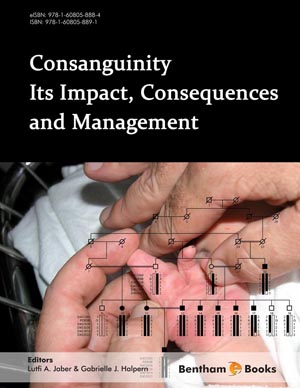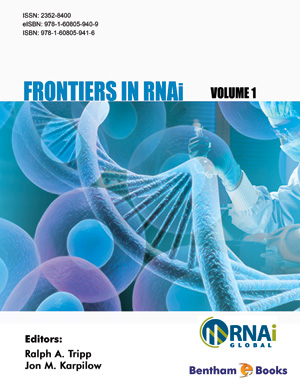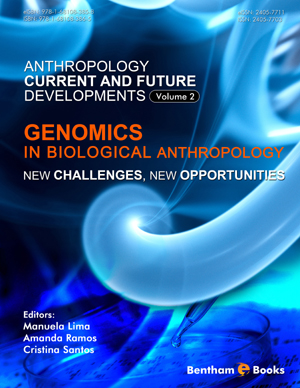Epidemiology and Prevalence of Down Syndrome
Page: 3-44 (42)
Author: Mohammed Al-Biltagi
DOI: 10.2174/9781681081342115010004
PDF Price: $30
Abstract
Down syndrome (DS) is the commonest chromosomal disorders in the world; affecting all countries, all races, and both sexes. It was identified since premodern art and middle ages. The risk for DS births is multi-factorial and includes both genetic and environmental factors. The prevalence of DS could be affected by different factors including distribution of maternal age in the population, adequacy and completeness of ascertainment, accurateness of diagnosis, level of selective prenatal termination of affected pregnancies, as well as different unrecognized genetic and environmental factors. Incidence of DS is expected to be significantly high in the developing countries, probably due to the higher death rate from comorbidities in DS such as congenital cardiovascular defects. Improving survival of infants with DS because of better care especially of cardiovascular malformations will affect prevalence rather than the incidence of DS. According to World Health Organization; the predictable incidence of DS is between 1 in 1,000 to 1 in 1,100 live births all over the world. The difference in prevalence among populations or countries or in the same population over time will depend on the potential risk factors in common for that community.
Genetics of Down Syndrome: An Update
Page: 45-60 (16)
Author: Solaf M. Elsayed
DOI: 10.2174/9781681081342115010005
PDF Price: $30
Abstract
Since the discovery of the chromosomal basis of Down syndrome (DS) in 1959, researches are still trying to understand the genetic basis of this particular unique common disorder that cannot be simply explained by an additional chromosome 21. Recent advances in molecular genetics had shed the light on several genes peculiar to this disorder like DYRK1A involved in cognitive dysfunctions and GATA1 involved in transient myeloproliferative disease. Some of these genes are actually beneficial when found in excess like COL18A1 which encodes endostatin, a potent angiogenesis inhibitor that inhibit the progression of solid tissue tumors and thus may have a potential therapeutic effect as anticancer therapy, as an anti-inflammatory agent and for protection against diabetic retinopathy. Gene therapy - or better to say chromosome therapy - for patients with DS is a recent break through where scientists were able to silence the extra chromosome and reverse the neuron proliferation dysfunction. This will not only help patients with DS but could be applied to all chromosomal trisomies. By understanding the pathogenetic mechanisms of DS, the near future is holding hope not only for treatment of DS cognitive dysfunction but also cures for solid tumours and certain disorders that will be done through inducing trisomy 21 in affected cells!
Neonates with Down Syndrome
Page: 31-106 (76)
Author: Mohammed Al-Biltagi and Adel A. Hagag
DOI: 10.2174/9781681081342115010006
PDF Price: $30
Abstract
Neonates with DS have many co morbidities that jeopardize this critical period of life with increased morbidity and mortality. They have more incidences of congenital heart diseases, pulmonary disorders, epilepsies, gastrointestinal anomalies, hematological problems as well as feeding disorders. They need to recognize their problems and for early intervention that could improve their medical conditions as well as their quality of life.
Cardiovascular Disorders in Children with Down Syndrome
Page: 107-170 (64)
Author: Mohammed Al-Biltagi and Osama Abd Rab Elrasoul Tolba
DOI: 10.2174/9781681081342115010007
PDF Price: $30
Abstract
Down syndrome (DS) is commonly associated with cardiovascular disorders either congenital or acquired. Congenital cardiac diseases (CHDs) occur in about half of children with DS. They also are more liable to have pulmonary hypertension, mitral valve prolapse, aortic regurgitation and many other acquired cardiac conditions. Meanwhile, they are also of a higher risk for developing obesity than the control children which predisposes them to an increased risk of atherosclerosis. Antenatal detection of DS as well as CHDs can be detected by presence of some soft signs during routine antenatal 4-chamber view. Children with this syndrome should have echocardiographic examination in the first month of life for all neonates, before any cardiac surgery, as follow-up after cardiac surgery, for serial evaluation of pulmonary hypertension, before involvement in major non-cardiac surgery and before involvement in physical exercise as well as serial follow up for early detection of any cardiac disorder. In this chapter, prevalence, pathomechanism and methods of detection of cardiac disorders in children with DS as well as their management are discussed.
Respiratory Problems in Children with Down Syndrome
Page: 171-222 (52)
Author: Mohammed Al-Biltagi
DOI: 10.2174/9781681081342115010008
PDF Price: $30
Abstract
Children with Down syndrome (DS) are more prone to have respiratory disorders which can be categorized into congenital structural disorders of the airways and lungs, acquired disorders, and sleep-related disorders and obstructive sleep apnea. Children with DS have a high incidence of airway anomalies; both upper and lower compared to non-DS children. The most important findings are hypoplasia of midface with dysfunction of malformed Eustachian tube, a short palate, hypoplastic nasal bones, choanal stenosis, macroglossia, enlarged adenoids and tonsils, lingual tonsils, and narrow oropharynx, and nasopharynx, abnormal oropharyngeal structures, laryngomalacia, tracheomalacia, congenital subglottic stenosis, tracheo-oesophageal fistula, bronchomalacia and branching and lung anomalies. Among the acquired respiratory disorders encountered in children with DS are respiratory infections including acute bronchiolitis due to infection with respiratory syncytial virus, pneumonia, infection with H1n1 stains of flu virus, high incidence of acute lung injury, occurrence of pulmonary hemosiderosis, increase incidence of pulmonary hypertension, GERD, and the possibility of having asthma. Sleep disorders are common and important problems, frequently under-recognized in children with DS and can be a significant distressing factor to their families. The prevalence of these disorders in children with DS is very high, particularly in boys. Vaccinations help to prevent a considerable number of infectious diseases. The immune dysfunctions of DS are not a contraindication for the currently available vaccines: their immunogenicity and safety are not significantly different from those observed in the general population.
Are Gastrointestinal Disorders of Real Concern in Children with Down Syndrome?
Page: 223-256 (34)
Author: Mohammed Al-Biltagi
DOI: 10.2174/9781681081342115010009
PDF Price: $30
Abstract
Down syndrome (DS) is a systemic disorder affecting the whole body including the gastrointestinal (GI) tract; from the oral cavity and ending with the anal canal that are involved in the food digestion absorption and excretion. These disorders could be anatomical or functional. About 10% of children born with DS have one or more forms of the structural abnormalities which may include tracheoesophageal fistula, congenital diaphragmatic hernia, small bowel obstruction, annular pancreas, and anal anomalies. Functional gastrointestinal disturbances include oral, esophageal, gastric and/or intestinal motility dysfunctions leading to feeding difficulties, prolonged feeding duration, dysphagia, gastro-oesophageal reflux disease, increased risk of aspiration, delayed gastric emptying, constipation, Hirschprung's disease and malnutrition with its effects on general health and physical compromise. These functional disturbances may be difficult to treat and may, in sequence, affect the prognosis of corrective surgeries, and hence need more cautions.
Infection in Children with Down Syndrome
Page: 257-297 (41)
Author: Nermin K. Saeed
DOI: 10.2174/9781681081342115010010
PDF Price: $30
Abstract
Infections are an important reason of increased morbidity and mortality in children with DS. Infection in children with DS characterized by increased severity of infection due to accentuated inflammatory response; increased the need for intensive care; prolonged duration of illness and need for extra or augmented treatment to cure the same infections compared with the normal population. In this chapter we will discuss the causes of increased infections in children with DS, the relation of infection to the pathogenesis of DS, the common infection in DS and immune modulation of children with DS. Every effort should be done to minimize the risk of infection and to improve their immunity.
Update in Hematology and Oncology in Down Syndrome
Page: 298-312 (15)
Author: Mohamed Ramadan El-Shanshory
DOI: 10.2174/9781681081342115010011
PDF Price: $30
Abstract
Down syndrome (DS) is commonly associated with hematological and oncologic disorders than non-syndromic children. Interpretation of the blood picture should be done with caution. Polycythemia and iron deficiency anemia (IDA); both are common in those children. Presence of IDA in DS children adds an extra load on them. Occurrence of transient abnormal myelopoiesis (TAM) in DS neonates is due to the effect of trisomy 21 on liver hematopoiesis with megakaryocyte – erythroid progenitor. Down syndrome children have a 500- fold increase in acute myeloblastic leukemia (AMKL) compared to the non-syndromic children. They also have increased risk for development of acute lymphoblastic leukemia (ALL) which affects 1 in 300 children with DS. At the same time; despite the high prevalence of leukemia’s in DS children; the risk for the development of solid tumors is globally unexpected to be low. Several novel therapies will benefit many children with DS and ALL and other malignancies.
Neurological Manifestations of Down Syndrome
Page: 313-347 (35)
Author: Ashraf El-Mitwalli
DOI: 10.2174/9781681081342115010012
PDF Price: $30
Abstract
Down syndrome is the most common chromosomal abnormality. A variety of neurological manifestations including stroke, epilepsy, cervical spinal cord compression, and basal ganglia damage may complicate the syndrome. As the neurologists have little chance to see a good number of DS patients and hence their expertise in this field is lesser than psychiatrists, it is suggested that cooperation between both neurologists and psychiatrists especially the learning disability might lead to better outcome of neurological complications of DS. This chapter reviews the commonest neurological complications associated with DS.
Psychological Change in Down Syndrome Children and Adolescents
Page: 348-384 (37)
Author: Mohammed Al-Biltagi, Fu Yong Jiao, Vivian Song, Feilan Lv, April Wang and Guoyan Lee
DOI: 10.2174/9781681081342115010013
PDF Price: $30
Abstract
Children and adolescents with DS are exposed to significant physical, sexual and emotional developmental changes. They also often have some psychiatric problems as externalizing disorders, depression, anxiety and/or obsessive-compulsive disorder.
They also suffer from behavior and psychosocial problems in the process of their growth, such as expressing their feelings, learning problems as their shortage of language and cognition. Children with DS are amenable for good education and they can enter a special education school for special education, so that training of their fine motor, gross motor and intellectual abilities is helpful to improve their development.
They can be encouraged to improve body functions and accentuating gaining more functional proficiencies that facilitate improving participation in age-suitable activities. Early detection and proper treatment of emotional, psychiatric or developmental disorders ensure good prognosis.
Anesthesia in Down Syndrome Children
Page: 385-418 (34)
Author: Mohammed Al-Biltagi, Hasan Alasy and Avijit Gaikwad
DOI: 10.2174/9781681081342115010014
PDF Price: $30
Abstract
Down syndrome (DS) Children are more liable for frequent sedation and anesthesia either for imaging procedure or for surgical intervention. They have many risk factors that increase the anesthesia related complications. These risk factors include cardiac, esophageal, gastrointestinal or urinary tracts, eyes, ears, and joints anomalies. There is also an increased risk of infection due to immune deficiency. Proper preoperative, operative and post operative management are mandatory to decrease the anesthesia-related complications. In this chapter; these co morbidities and the factors that increase the risk of complications during anesthesia will be addressed, as well as pre-operative, intraoperative and post-operative management will be discussed.
Dental Problems in Down Syndrome Children
Page: 419-466 (48)
Author: Mohammed Al-Biltagi, Ahmed Kamal Saeed, John Jacob Meakkara and Vikas Raj Somarajan
DOI: 10.2174/9781681081342115010015
PDF Price: $30
Abstract
Down syndrome (DS) is a common malformation affecting the whole body with a unique craniofacial and distinctive oral feature and anomalies. These dental anomalies and the associated systemic manifestations of children with DS pose real challenges to the dentist as well as the pediatrician which necessitate a multidisciplinary team to be involved in taking care of children with this syndrome. It is important that the dentist can recognize the types of structural soft tissue and dental abnormalities which are part of the classic features and developmental prototype of D children. The dentist should also be able to detect and to appropriately manage these problems through an integrated team work including the family and the child primary physician. Good oral hygiene and healthy dental life are of paramount importance for an integrated health and better quality of life for such children.
Introduction
This book describes different medical problems that children with Down syndrome can encounter. Twelve chapters written by medical experts present information about the disease and give general guidelines for pediatric care. Readers are introduced to the epidemiology and risk factors associated with Down Syndrome followed by descriptions of medical issues related to the disease in children. These include neonatal problems, cardiac defects, respiratory disorders, gastrointestinal problems, nervous system disorders, dental disorders and more. The book also includes information on mental health development and social issues that arise in the lives of affected children. This handbook will be essential for medical students, healthcare professionals and special education personnel who are involved in the care of children with Down syndrome.


















